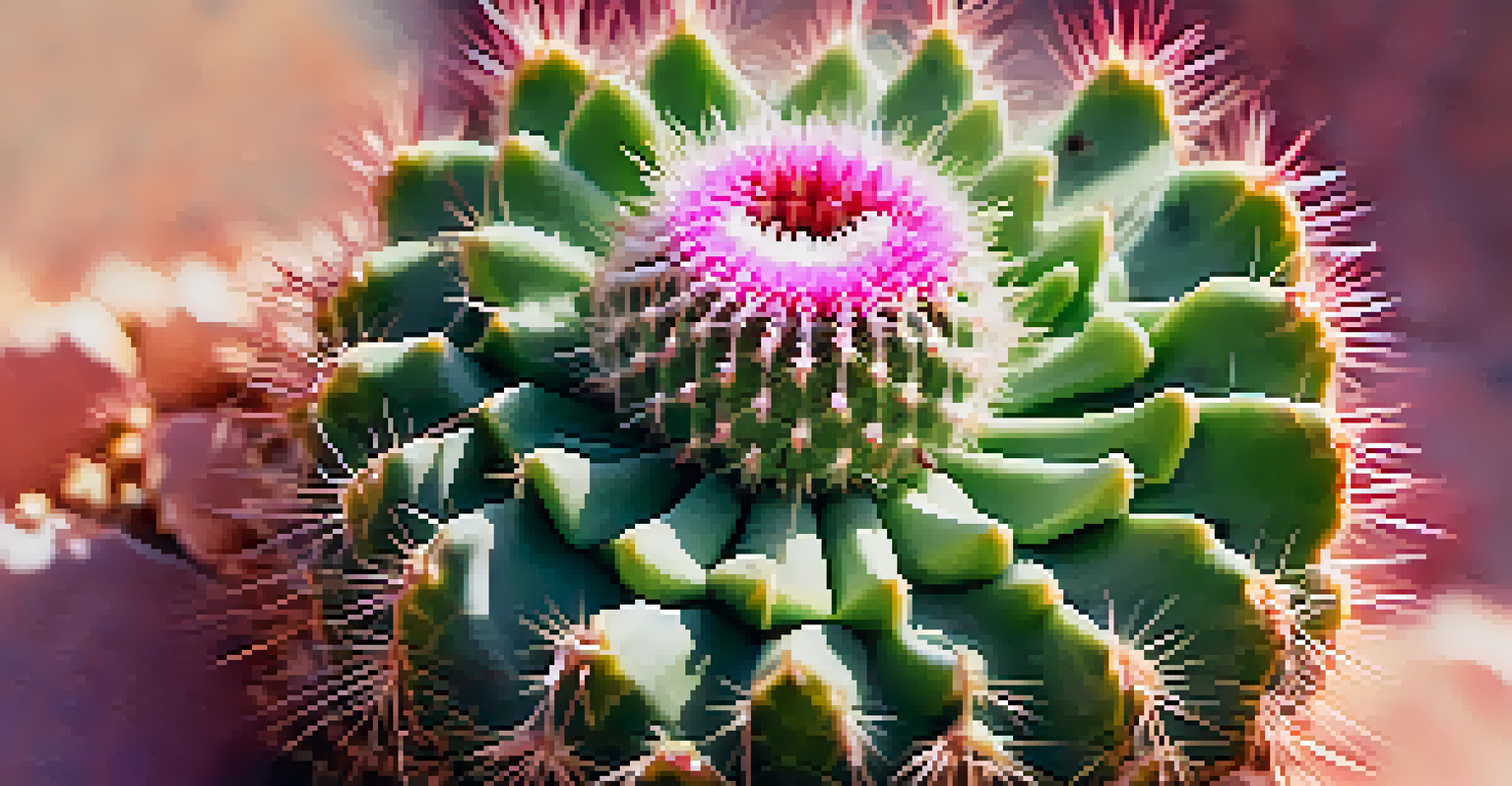Peyote and the Healing Landscape: A Natural Connection

Understanding Peyote: A Sacred Cactus with Healing Powers
Peyote, a small, spineless cactus native to the deserts of Mexico and the southwestern United States, has been used for centuries in spiritual and healing practices. Its psychoactive properties, primarily due to the compound mescaline, have made it a key element in various indigenous rituals. While many people associate peyote with its hallucinogenic effects, it is essential to recognize its profound cultural and medicinal significance.
The use of natural elements in healing practices connects individuals to something greater than themselves, fostering a sense of belonging and purpose.
Traditionally, peyote is consumed in ceremonial settings, where it’s believed to facilitate deep introspection and connection with the spiritual realm. Shamans and spiritual leaders often guide participants, helping them navigate their experiences. This collective approach to healing highlights the importance of community and shared wisdom in indigenous cultures, creating a safe space for transformation.
Apart from its spiritual applications, peyote has also been studied for its potential therapeutic benefits. Research suggests that mescaline may help alleviate symptoms of anxiety, depression, and PTSD. However, it is crucial to approach these findings with respect for the cultural context in which peyote is used, ensuring that its sacredness is honored in modern healing practices.
The Role of Nature in Healing: A Holistic Perspective
Nature has long been recognized as a source of healing and rejuvenation. The sights, sounds, and smells of the natural environment can significantly impact our mental and emotional well-being. Studies have shown that spending time outdoors can reduce stress, improve mood, and enhance overall mental health, making it a vital component of holistic healing.

Incorporating nature into healing practices allows individuals to reconnect with themselves and the world around them. This connection fosters a sense of belonging and purpose, which can be especially beneficial for those struggling with mental health issues. For many, experiences in nature can be as transformative as traditional therapies, reinforcing the idea that healing can come from multiple sources.
Peyote's Cultural and Spiritual Roots
Peyote is not just a hallucinogenic substance; it holds deep cultural and spiritual significance for many indigenous communities.
Peyote, as a natural element, embodies this connection to the healing landscape. Consuming it within a natural setting can amplify its effects, allowing individuals to tap into the energy of the earth. This synergy between peyote and nature highlights a broader understanding of healing—one that encompasses not only the mind and body but also the spirit and the environment.
Cultural Significance of Peyote: Bridging Tradition and Modernity
The use of peyote is deeply rooted in the traditions of various Native American tribes, where it is often viewed as a gift from the Creator. Its consumption is more than just a means of altering consciousness; it's a spiritual journey that connects individuals with their ancestors and the universe. This cultural significance is crucial, as it reflects a worldview where nature, spirituality, and healing are intertwined.
We must honor the cultural significance of sacred plants like peyote, ensuring that their use remains rooted in tradition and respect for the communities that hold them dear.
In recent years, there has been a growing interest in psychedelics for therapeutic purposes, leading to a resurgence of interest in peyote. However, this modern fascination must be approached with caution and respect. Many indigenous communities feel that the commercialization of peyote undermines its sacred use and threatens its availability for future generations.
To honor peyote’s cultural roots, it’s vital to support indigenous rights and ensure that these practices remain within their traditional contexts. Education about the historical and spiritual significance of peyote can help bridge the gap between modern therapeutic use and traditional practices, fostering a deeper understanding of its role in healing.
The Science Behind Peyote: Understanding Its Psychoactive Effects
The psychoactive properties of peyote are primarily due to mescaline, a naturally occurring alkaloid that alters perception and consciousness. When consumed, mescaline interacts with serotonin receptors in the brain, leading to enhanced sensory experiences and altered thought patterns. This is why peyote is often associated with visions and profound introspective journeys.
Research into the effects of mescaline has revealed potential benefits beyond its psychedelic experience. For instance, some studies suggest that it may promote neuroplasticity, the brain's ability to reorganize itself by forming new neural connections. This property could play a crucial role in the treatment of various mental health disorders, further underscoring the need for respectful exploration of peyote's therapeutic potential.
Nature Enhances the Healing Process
Connecting with nature during peyote ceremonies can amplify its healing effects, promoting a holistic approach to wellness.
However, it's essential to approach the use of peyote with caution and awareness. While the scientific interest in psychedelics is growing, individuals should consider the cultural implications and ethical concerns surrounding its use. Understanding the science behind peyote can help demystify its effects, but it should always be accompanied by a deep respect for its traditional significance.
Peyote Ceremonies: A Journey of Healing and Connection
Peyote ceremonies are integral to the healing practices of many indigenous cultures. These rituals often involve a group of participants coming together to consume peyote under the guidance of a knowledgeable leader. The ceremony typically lasts for several hours, providing a structured environment for introspection, dialogue, and spiritual exploration.
During these ceremonies, individuals may experience a range of emotions and insights that can lead to personal revelations and healing. The communal aspect of these gatherings fosters a sense of support and solidarity, as participants share their journeys and insights with one another. This shared experience can be incredibly powerful, reinforcing the idea that healing is a collective endeavor.
Moreover, peyote ceremonies often include music, prayers, and traditional practices that further enhance the experience. These elements create a sacred space where participants can connect with their spirituality and the natural world. By honoring these traditions, we can appreciate the profound benefits that such ceremonies offer in the context of healing and transformation.
Challenges Facing Peyote: Preservation and Ethical Considerations
As interest in peyote grows, so do the challenges associated with its preservation and ethical use. Overharvesting and habitat destruction pose significant threats to this sacred cactus, leading to concerns about its long-term viability. Without proper conservation efforts, future generations may lose access to this important plant and the healing traditions surrounding it.
Additionally, the commercialization of peyote raises ethical questions about its use outside traditional contexts. As more people seek out peyote for recreational or therapeutic purposes, it is essential to consider the impact on indigenous communities and their rights. Ensuring that these practices remain rooted in their cultural significance is vital for preserving their integrity.
Ethical Challenges in Peyote Use
The increasing interest in peyote raises ethical concerns about preservation and the potential commercialization of this sacred cactus.
Advocating for sustainable practices and supporting indigenous-led initiatives can help protect peyote and its cultural heritage. By raising awareness about the challenges facing this sacred cactus, we can contribute to its preservation and honor the traditions that have relied on it for generations.
The Future of Peyote: Integrating Tradition and Modern Healing
The future of peyote lies in its ability to bridge traditional practices with modern therapeutic approaches. As society increasingly recognizes the potential benefits of psychedelics for mental health, there is an opportunity to create respectful and informed pathways for their use. This integration can help honor the cultural significance of peyote while also exploring its healing potential.
Collaboration between indigenous communities and modern healthcare practitioners can lead to innovative approaches that respect traditional practices. By valuing the wisdom of indigenous cultures, we can create a more holistic understanding of healing that encompasses both ancient knowledge and contemporary science. This synergy can empower individuals on their healing journeys, providing them with diverse tools and perspectives.

Ultimately, the future of peyote and its role in healing will depend on our collective commitment to preservation, respect, and understanding. By prioritizing education and ethical considerations, we can ensure that the sacredness of peyote is honored while allowing its transformative properties to benefit those in need. This balance will pave the way for a more inclusive and compassionate approach to healing.